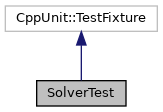#include <solvertest.hpp>
Definition at line 29 of file solvertest.hpp.
◆ CPPUNIT_TEST() [1/15]
◆ CPPUNIT_TEST() [2/15]
◆ CPPUNIT_TEST() [3/15]
◆ CPPUNIT_TEST() [4/15]
◆ CPPUNIT_TEST() [5/15]
◆ CPPUNIT_TEST() [6/15]
◆ CPPUNIT_TEST() [7/15]
◆ CPPUNIT_TEST() [8/15]
◆ CPPUNIT_TEST() [9/15]
◆ CPPUNIT_TEST() [10/15]
◆ CPPUNIT_TEST() [11/15]
◆ CPPUNIT_TEST() [12/15]
◆ CPPUNIT_TEST() [13/15]
◆ CPPUNIT_TEST() [14/15]
◆ CPPUNIT_TEST() [15/15]
◆ CPPUNIT_TEST_SUITE()
◆ CPPUNIT_TEST_SUITE_END()
| SolverTest::CPPUNIT_TEST_SUITE_END |
( |
| ) |
|
|
private |
◆ ExternalWrenchEstimatorTest()
| void SolverTest::ExternalWrenchEstimatorTest |
( |
| ) |
|
Closed-loop test for the external wrench estimator class: Simple controlled behaviour of the robot subjected to an external force is simulated. The external wrench estimator is called in each iteration of the control loop so to converge to final wrench value. In the end, estimated wrench is compared to the ground-truth values of the simulated wrench.
This EPS has a slightly different purpose than the EPSes of the other solver-tests. While other EPSes are taking care of the differences that originate from e.g. floating-number imprecisions, different compilers (or same compiler but different flags) used between different machines (OS), etc. The EPS specified below is there to cover those imperfections as well but, it's also there to take into account the noise in estimated signals (the differences between estimated and ground-truth wrenches), caused by other computations in this test (ones coming from the implemented controller and the dynamics simulator) not just those coming from the estimator itself.
Definition at line 1563 of file solvertest.cpp.
◆ FdAndVereshchaginSolversConsistencyTest()
| void SolverTest::FdAndVereshchaginSolversConsistencyTest |
( |
| ) |
|
Compute the forward dynamics (joint accelearitions given actuator torques) using both solvers and test for consistency
Definition at line 1442 of file solvertest.cpp.
◆ FdSolverConsistencyTest()
| void SolverTest::FdSolverConsistencyTest |
( |
| ) |
|
◆ FdSolverDevelopmentTest()
| void SolverTest::FdSolverDevelopmentTest |
( |
| ) |
|
◆ FkPosAndIkPosLocal()
◆ FkPosAndIkPosTest()
| void SolverTest::FkPosAndIkPosTest |
( |
| ) |
|
◆ FkPosAndJacLocal()
◆ FkPosAndJacTest()
| void SolverTest::FkPosAndJacTest |
( |
| ) |
|
◆ FkPosVectTest()
| void SolverTest::FkPosVectTest |
( |
| ) |
|
◆ FkVelAndIkVelLocal()
◆ FkVelAndIkVelTest()
| void SolverTest::FkVelAndIkVelTest |
( |
| ) |
|
◆ FkVelAndJacLocal()
◆ FkVelAndJacTest()
| void SolverTest::FkVelAndJacTest |
( |
| ) |
|
◆ FkVelVectTest()
| void SolverTest::FkVelVectTest |
( |
| ) |
|
◆ IkSingularValueTest()
| void SolverTest::IkSingularValueTest |
( |
| ) |
|
◆ IkVelSolverWDLSTest()
| void SolverTest::IkVelSolverWDLSTest |
( |
| ) |
|
◆ LDLdecompTest()
| void SolverTest::LDLdecompTest |
( |
| ) |
|
◆ setUp()
| void SolverTest::setUp |
( |
| ) |
|
KUKA LWR 4 Chain with Dynamics Parameters (for Forward Dynamics and Vereshchagin solver tests) Necessary test model for the Vereshchagin solver: KDL's implementation of the Vereshchagin solver can only work with the robot chains that have equal number of joints and segments. Note: Joint effective inertia values in this model are closely aligned with the joint inertia of the real robot. These parameters are published in: Jubien, A., Gautier, M. and Janot, A., "Dynamic identification of the Kuka LWR robot using motor torques and joint torque sensors data.", IFAC Proceedings Volumes, 2014., 47(3), pp.8391-8396.
Definition at line 13 of file solvertest.cpp.
◆ tearDown()
| void SolverTest::tearDown |
( |
| ) |
|
◆ UpdateChainTest()
| void SolverTest::UpdateChainTest |
( |
| ) |
|
◆ VereshchaginTest()
| void SolverTest::VereshchaginTest |
( |
| ) |
|
Compute Hybrid Dynamics for KUKA LWR 4.
Test setup:
- Operational-space task imposes acceleration constraints on the end-effector
- External forces and feedforward joint torques are acting on the robot's structure, as disturbances from the environment
Expected result:
- The solver computes the required joint torque commands (joint constraint torques) that satisfy imposed acceleration constraints and at the same time, compensate for the above mentioned disturbances
Method to evaluate:
- Compare the resultant Cartesian accelerations of the end-effector's segment with the task-specified acceleration constraints
Definition of the Cartesian Acceleration Constraints imposed on the end-effector. Note: the Vereshchagin solver expects that the input values in alpha parameters (unit constraint forces) are expressed w.r.t. robot's base frame. However, the acceleration energy setpoints, i.e. beta parameters, are expressed w.r.t. above defined unit constraint forces. More specifically, each DOF (element) in beta parameter corresponds to its respective DOF (column) of the unit constraint force matrix (alpha).
Definition at line 818 of file solvertest.cpp.
◆ chain1
◆ chain2
◆ chain3
◆ chain4
◆ chaindyn
| Chain SolverTest::chaindyn |
|
private |
◆ kukaLWR
| Chain SolverTest::kukaLWR |
|
private |
◆ motomansia10
| Chain SolverTest::motomansia10 |
|
private |
◆ motomansia10dyn
| Chain SolverTest::motomansia10dyn |
|
private |
The documentation for this class was generated from the following files:
